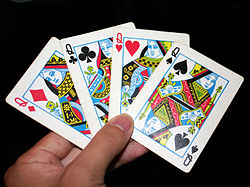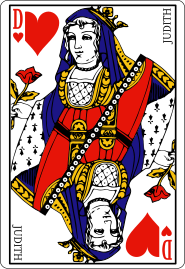
The queen is a playing card with a picture of a queen on it. In many European languages, the king and queen begin with the same letter so the latter is often called dame (lady) or variations thereof. In French playing cards, the usual rank of a queen is between the king and the jack. In tarot decks, it outranks the knight which in turn outranks the jack. In the Spanish deck and some Italian decks, the Queen does not exist and the Horse or Bull appears in them instead, with the same role and value.
Contents
In several card games, including the middle eastern Trex and French Barbu, the queen is a major card to avoid taking, with each queen taken inflicting a penalty on the player. Similarly, in Hearts, the queen of spades is to be avoided, and is called a variety of unsavoury names.
In the Paris pattern, each court card is identified as a particular historical or mythological personage as follows: [1] [2]
Queens may have been an invention of early German cardmakers. One of the earliest surviving packs of playing cards, the Stuttgart pack (circa 1440), consists of all female courts in two of the four suits where Queens have replaced Kings. The Ambraser Hofjagdspiel (circa 1440 to 1445) and many other surviving 15th-century packs include the Queen as a fourth independent rank from the King, Ober, and Unter. Modern German-suited playing cards have dropped the Queen rank, but French-suited playing cards have since adopted it as a replacement for the Knights. [3]




